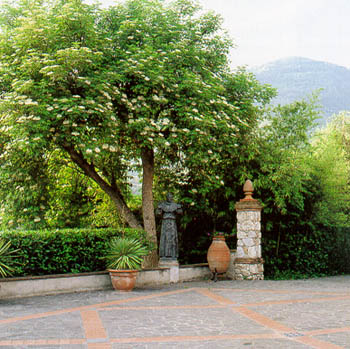![]()
|
|
|
The Piazza in front of the house with a statue of St. Francis |
Joseph Sheppard bought this typical Italian farmhouse — stone-and-mortar with a shallow terra-cotta-style roof supported by vast exposed beams — 11 years ago, after a decade of splitting his time between Baltimore and a rented villa in Florence. "I'd been looking for a house for years, but property in Italy is very hard to come by," he tells me.
He had visited Pietrasanta during one of his explorations of the countryside and found himself very taken with this little artist colony situated near the coastal towns of Massa and Carrara, where marble has been quarried for more than 2,000 years. He also found himself drawn by the marble-worker's art that is the town's main industry. Pietrasanta has more than 100 commercial and private marble studios and seven bronze foundries.
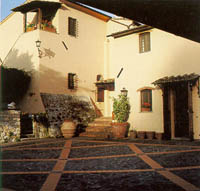 |
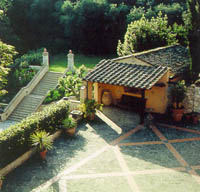 |
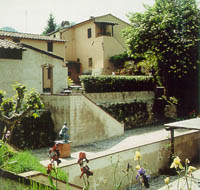 |
|
View of the house near Pietrasanta |
When Joe found the ramshackle farmhouse with its eight acres of land and grove of olive trees for sale, he figured he'd found not only a home, but also a new artistic focus. Best known as a painter, he has completed a portrait of former President George Bush that will hang in the Bush Library in Houston come November, and he has painted several portraits of William Donald Schaefer, both as Baltimore's mayor and Maryland's governor. It was only here in Pietrasanta, whose name translates as "holy stone", that Joe fully developed his sculpting.
When his chance came to buy the farmhouse, he didn't take a lot to time to mull over the decision. "A friend, who'd also been looking for a place for years, had found this house and put a deposit on it. Then, almost immediately, he found a much larger place in Pisa. I looked at this farmhouse and said I'd take it that same day. I agreed to buy it without even seeing the kitchen, because the door was locked and we couldn't get in to see it," he recalls with laughter.
In the interest of economy, and to satisfy Italian property laws, Joe bought most of the land but only half the house. Moreno Meccheri, a tenant farmer who was born on the land, occupies the other side, along with his wife and, until her recent death at age 88, his mother. Moreno cares for and harvests the 100-plus trees in the olive grove and tends the vegetable garden, keeping half the olive oil and garden produce for himself.
"I had to gut the house," says Joe about what turned into a huge renovation project. "What's now the kitchen and my big studio were animal stalls. There was a hole in the roof, no windows, and no water or electricity. The house had stood empty for 60 years." The most livable part of the house at that time were the rooms above the stalls. They became the guest apartment, eventually boasting two bedrooms, a kitchen and dining area, a living room with a fireplace, and a small den. Joe lived here, in varying stages of comfort, while the renovations were under way.
He gave his art the room it needed, installing a painting studio directly below the apartment and constructing a marble studio on the footprint of an original shed on the edge of the courtyard. It is in this three-sided brick building that Joe makes the models for his marbles and bronzes.
Alongside the driveway, climbing the gentle slope toward the gate to the property, is Joe's sculpture garden. Several dramatic fragments from his large sculpture at Baltimore's Holocaust Memorial Plaza share the landscaped sculpture garden with works of a more classical bent.
The house renovations were still under way when Joe met Rita. Adding an interior designer to the mix might have proved a volatile element in Joe's ongoing home project, but their collaboration seems to have worked out beautifully. Both agree that the character of the farmhouse should be maintained, so furniture is simple and rustic.
— Kate Tyndall
Excerpt from Style Magazine
July/August 1997
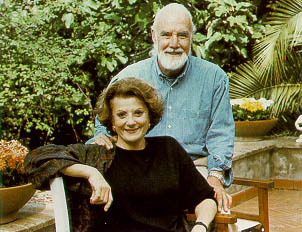
Joe and Rita on the terrace
